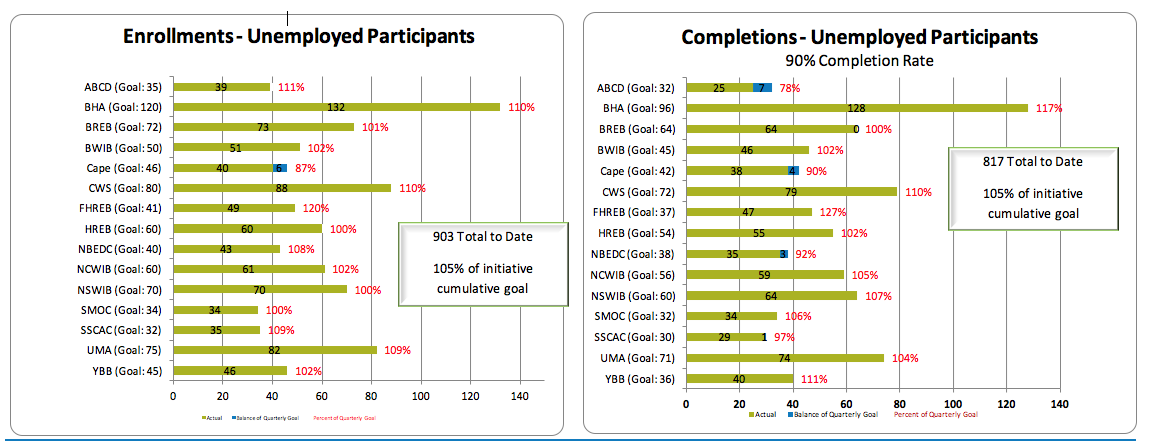作为 南希介绍,这是我们春季 WCTF 博客系列的四篇文章中的第二篇, 实现有影响力的成果:WCTF 的观察.在今天的帖子中,项目总监 Theresa Rowland 将讨论数据驱动的意义。
What does data driven-mean? And how do programs ensure they are doing it? To us, data-driven is identifying and using data to help make decisions about the programs we fund. In my 10 years of experience at CommCorp, I have come to learn the value of being data-driven. We ask partnerships to be data-driven from the beginning of any program by engaging employers to identify local real time demand for target occupations. Partnerships are required to talk with employers in their region who are hiring for their identified target occupation, and then learn everything they can about the employers’ skill, credential and hiring requirements. While publicly available data sets are helpful in figuring out which employers to start to talk with, building the case for the demand and need for a training program is only made by talking with real local employers who can provide information on the number of vacancies they currently have, the number they anticipate needing to fill over the next 1-2 years and are committed to partnering to fill their vacancies. We also ask partnerships to continue to be data-driven in managing and measuring the success of their programs. It helps that we are very clear on the goal of sector strategies programs – to place participants in stable positions with opportunities for advancement. Partnerships propose goals and track data using a participant level database for the following indicators:- 主要目标:工作安置
- 中期指标:
- 注册
- 证书获得
- 培训完成
 仪表板并不能回答我们所有的问题,但可以帮助我们找到正确的方向,开始探索问题的根本原因并开始确定中期修正。例如,证书获得率低可能会导致各种问题,包括与证书考试不一致的培训课程、培训结束日期和证书考试之间的大量时间间隔或读写/计算障碍。这些数据提醒我们一个潜在的问题,需要额外的探索和对话才能理解。
仪表板并不能回答我们所有的问题,但可以帮助我们找到正确的方向,开始探索问题的根本原因并开始确定中期修正。例如,证书获得率低可能会导致各种问题,包括与证书考试不一致的培训课程、培训结束日期和证书考试之间的大量时间间隔或读写/计算障碍。这些数据提醒我们一个潜在的问题,需要额外的探索和对话才能理解。
 Another dashboard used to make program decisions is the demographic report. This helps us understand more about the individuals being served by the programs we fund. We can even look at whether there are certain populations achieving higher rates of employment outcomes by program to help understand any relationship between the demographic profile of an individual and their likelihood of entering employment. This is an important data point to ensure programs are working to support all program participants. For example, if a program was placing a lower proportion of individuals without a high school diploma than individuals with a high school diploma, the program may want to review their selection criteria or design an additional component of the program to provide additional literacy skills to this population.
Data-driven is more than just crunching some numbers. The real fun is using data to point you in the direction toward meaningful conversations with program participants and partners to understand what is really going on in your programs and how to make mid-course corrections to ensure your program meets your partnership’s goals.
由 Commonwealth Corporation 部门就业倡议项目主任 Theresa Rowland 撰写。在过去的 10 年里,特蕾莎一直通过劳动力竞争力信托基金制作和管理赠款。
Another dashboard used to make program decisions is the demographic report. This helps us understand more about the individuals being served by the programs we fund. We can even look at whether there are certain populations achieving higher rates of employment outcomes by program to help understand any relationship between the demographic profile of an individual and their likelihood of entering employment. This is an important data point to ensure programs are working to support all program participants. For example, if a program was placing a lower proportion of individuals without a high school diploma than individuals with a high school diploma, the program may want to review their selection criteria or design an additional component of the program to provide additional literacy skills to this population.
Data-driven is more than just crunching some numbers. The real fun is using data to point you in the direction toward meaningful conversations with program participants and partners to understand what is really going on in your programs and how to make mid-course corrections to ensure your program meets your partnership’s goals.
由 Commonwealth Corporation 部门就业倡议项目主任 Theresa Rowland 撰写。在过去的 10 年里,特蕾莎一直通过劳动力竞争力信托基金制作和管理赠款。 